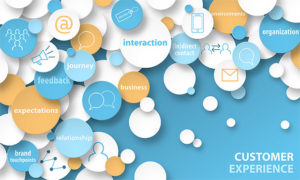Over the course of the past year, adjusting to the challenges of the pandemic on business has made the customer relationship management system an essential tool for maintaining and growing a customer base. As a result, CRM platforms have evolved into something more than just a digital Rolodex to manage customer contacts.
A key aspect of succeeding in customer management tasks involves addressing the customer experience. Brands and retailers need to become customer-obsessed in 2021 in order to improve the customer experience, suggested Jennifer Conklin, sector lead of unified commerce at Capgemini North America.
With most workers continuing to work remotely, CRM has become an important tool for managing relationship risk. Financial firms have to deal with market and operational risk, consumer retailers have to focus on supply chain risk, and all companies have to keep an eye on economic risk.
Relationship risk is no different, and the role of the CRM is right at the center. Diverse fulfillment methods are key to customer experience (CX) success for merchants this year.
Marketing now must focus on four key trends — contactless customer experience, omnichannel shopping, personalizing and changing customer journeys, and voice commerce, according to Conklin. That litany is what marketers can expect as the new normal in 2021 for CX and commerce trends.
“With safety still top of mind, a contactless shopping experience will be very relevant in 2021. Because health and safety concerns are a priority for most consumers, voiceless technology offers a safe, touchless alternative,” she told CRM Buyer.
Fixing a Broken CX
Improved functionality is at the heart of improving the customer experience. That all hinges on taking care of functionality issues. This approach involves curbside pick-up, touchless in-store pick-up, buy online pick-up in-store (BOPIS), and its sister strategy: reserve online pick-up in-store (ROPIS).
These are all shopping options that meet the customers where they want to shop. Merchants that make buying and pick-up easy and seamless will win in 2021, noted Conklin.
“It also depends on an organization’s level of technical maturity. Where are they in their digital transformation?” she said.
Some merchants were quick to pivot in 2020. Others were in mid-pivot when the pandemic began. That way, their efforts could be accelerated and prioritized in order to meet new expectations, explained Conklin.
“However, the laggards will be far behind and still need to tackle basic optimizations like mobile shopping and fast page-load times,” she surmised.
How do they do that? It all starts with data to help achieve one holistic view of the customer, which in turn provides a seamless experience across any touchpoint throughout the customer journey.
CRM’s Newfound Importance
CRM is becoming more important now than ever before, according to Manish Patel, Tier1 Financial Solution’s chief operating officer of its CRM business. Much of that results from the shift to the online business world.
“As industries become increasingly virtual and rely more heavily upon cloud-based technology, it is imperative that foundational products like CRMs provide the flexibility and accessibility that allows professionals to work from any location at any time,” he told CRM Buyer.
The appetite for more nimbleness in a CRM was already growing heading into 2020. But the pandemic accelerated the adoption of these capabilities, making robust platforms no longer a “nice to have” item but a “need to have” necessity, he added.
“Today’s CRM not only makes jobs more organized and efficient, but it mitigates a great deal of operational and relationship risk, particularly in what has become a completely distributed workforce for many firms,” Patel said.
Essential in Capital and Investment Markets
Capital markets and investment banking are areas where CRM is more important than ever. It is far more than just a contacts app for sales teams.
“A CRM needs to be more of a Swiss Army Knife of functionality when it comes to managing relationships. Sales and trading teams need to have real-time access to what has happened, what is happening, and what should they do next, along with the ability to manage events, in order to drive revenue-generating engagements,” Patel said.
Investment banking professionals need the ability to quickly identify the right buyers based on historical transaction types, interests, and current holdings. A premium CRM filters their preferences, which can lead to a higher success-hit ratio when targeting buyers for a deal, he explained.
CRM’s Evolving Nature
Historically, a CRM system, at its foundation, has been a resource for storing and organizing client contact details. However, as the industry landscape has become more digital and more reliant upon data, CRMs have become an enterprise-wide data repository.
“Today’s CRM connects data and helps put context around information, giving users a 360-degree view of the client,” noted Patel.
CRM technology is becoming more sophisticated because that is what clients need in an ecosystem that’s getting more crowded, more complex, and more competitive. Firms have to manage a greater number and a wider array of clients than in years past.
This means that there are oceans of data that have to be organized. The expanded functionality has especially helped banking and capital markets professionals uncover new opportunities and provides more substantial insights to engage with clients, according to Patel.
“I think where we are seeing CRMs, particularly within the financial sector, evolve to is one of greater interoperability. Key data providers are integrating with CRMs to make data management more efficient and accessible, and that will continue to be the case over the next one to five years,” he added.
More Than a Sales Team Tool
CRM systems play an increasing role across organizations. The platform is no longer just for sales teams.
“Vendors are also realizing the need to collaborate, partner, and integrate with other specialists to empower the increasingly virtual ecosystem,” Patel offered.
A CRM platform, in many ways, is the bedrock of any company’s technology stack, particularly among a distributed workforce. It provides so much functionality and workflow efficiency in today’s landscape that it is almost impossible to think how a company, even small and mid-sized startups, could function without one.
CRM platforms are serving as an intuitive digital dashboard that provides a complete, single-pane-of-glass view of a client. They manage not only all of the contact and deal information that sales teams have always needed. They also mitigate risk and allow clients to operate from anywhere, acting as an undisputed single source of truth.
“Firms should no longer have to dig through endless amounts of spreadsheets and an array of different platforms to align client information and make informed decisions,” Patel insisted.
What Merchants Need To Do
Technology researcher Forrester predicts that 25 percent of businesses will achieve significant customer experience gains in the coming year following the organizational shock of the pandemic, according to Durk Stelter, chief revenue officer of Linc Global. Teams that evaluate their crisis response and implement digital and omnichannel strategies to address gaps will recover their stride quickly.
“They are likely to find that consolidating and unifying around the right technologies will result in cost reduction and increased customer satisfaction,” he told CRM Buyer.
Improving customer experience is a partnership with CRM technology. Underpinning these changes is AI-powered automation.
It helps retailers process the vast amounts of data necessary to power at scale the rich online experiences customers now expect. These involve e-commerce site analytics GPS location information to real-time inventory status updates from local stores.
Interactions must be swift and consistent wherever shoppers choose to engage with the brand and deliver complete resolution. Automated online solutions must solve problems, not just deliver basic information. Otherwise, they can be perceived as time wasters that merely stall customers until a human customer service agent can take over, Stelter explained.



























































Social CRM
See all Social CRM